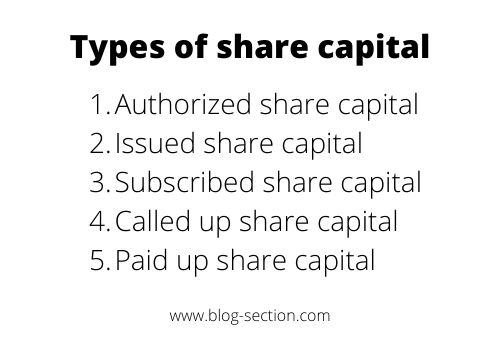Table of Contents
Before reading the different types of share capital, it is advisable to know the meaning of share capital.
Meaning of share capital:
Share capital is the sum of money received by a company by selling its shares to the investors. When a company issues fresh share to the investors and raises fund, it directly increases the value of share capital.
The amount of total share capital cannot be more than the amount of authorized share capital of a company. Increase in market price of shares does not affect the value of share capital because share capital is calculated based on the par value of shares and not on the basis of market price.
Share capital is shown on the balance sheet of a company.
Types of share capital:

Share capital can be categorized as authorized share capital, issued share capital, subscribed share capital, called up share capital and paid up share capital.
Authorized:
Authorized share capital refers to the total capital that a company is authorized to accept from investors by issuing shares. In simple terms, a company cannot raise capital more than its authorized capital.
It represents the capital with which a company is registered that’s why it is also known as ‘registered capital’.
Issued:
It represents that part of total authorized share capital which has been issued by a company for subscription by investors. Usually, companies do not issue all of their shares for control purpose. Thus, the part which is issued represents the issued share capital.
Subscribed:
It refers to that part of issued share capital, which has been subscribed by investors. It means when a company issues shares to raise capital, it may or may not receive subscriptions for all of its shares. The part of issued share capital for which subscription has been received is known as subscribed share capital. So subscribed share capital can be equal to subscribed share capital but not more than that.
Called up:
In general practice, a company collects the full amount of share price in more than one lot. The part of subscribed share capital which has been asked for payment represents called up share capital.
Paid up:
One of the types of share capital, paid up capital represents that part of called up share capital which has been paid by investors.
Paid up capital = Called up capital – Call in arrears.
Example of different types of share capital:
Suppose ABC Ltd. is registered with a capital of Rs 1,00,00,000 divided into shares of Rs 10 each. The company issued 8,00,000 shares to raise a fund of Rs 80,00,000 but investors subscribed for 6,00,000 shares. The company asked for Rs 4 per share out of Rs 10 (Nominal value of shares) and it received payment for only 5,50,000 shares.
Now,
Authorized share capital (10,00,000 shares of 10 each) = 1,00,00,000
Issued share capital (8,00,000 shares of 10 each) = 80,00,000
Subscribed share capital (6,00,000 shares of 10 each) = 60,00,000
Called up share capital (6,00,000 × 4) = 24,00,000
Paid up share capital (5,50,000 × 4) = 22,00,000
Call in arrears (50,000 × 4) = 2,00,000

What are the different types of shares a venture funds takes in a company? What is series A funding etc.?
Hi Xavier,
Venture capital funds take ownership in a company while providing it fund to operate. This ownership is direct in form of private equity.
A Series Funding: Series A funding is first round of funding after obtaining seed capital. This funding in contrast to seed capital, involves external parties and investment is made through preferential shares.
Sir about reserve capital ?
Hi Neha,
Reserve capital is the part of authorized capital that has not been called up. The company can make use of such capital only in the event of liquidation.
Thank you sir!
What about equity share capital and preference share capital. are these not types of share capital? If NO, under what head do this form part?
Equity and preference are types of shares and not share capital.
Notes are good but didn’t see deserved share capital
You mean reserved capital, right?
Wowwww.. very simple for understanding.. thanks..
We are glad to hear that you liked it.
Sir the explanation abt all these types are fantastic but what abt reserve capital? Can u explain it plz
Glad that you liked this article!
Reserve capital is the part of authorized share capital which has been kept reserved for future drawings. If we proceed with the given example in this article then the amount of reserve capital is 20 lakh (2 lakh unissued shares of Rs. 10 each).
Please let us know if you want further help on this.
Hi Vikas, Nice, U made it look simple. Thanks.
Hi Kantaraj, Thanks for such a nice comment!
Of all…. This is the best notes I’ve read. … Brief and understandable explanation…. I really love them…
Hope that you liked our other articles too.
wow, superb man. very clear cut explination. well done and keep it up…
Thank you K tarakarama palavalasa!
Well explained.. thanks
Glad you liked it!
Very simple and clear explanation…..Thanks a lot for posting each and every topic with simple explanation.
Thanks for the admiration!